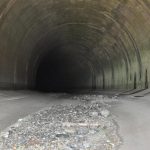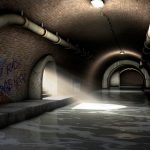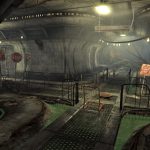By: Matt Lopez (Level Designer)
Sites and References:
- CityLab – Talks about why and the importance of steam coming from the manholes in cities occurs.
- The Atlantic – A brief, but in-depth overview of the history of sewers in the US.
- Scientific American– A historic retelling of the evolution of sewers from the Roman Aqueducts to modern day sewage systems and how they work. It also talks about the various types of waste disposal and blockages that can occur in a sewer system. Warning: This is a very, very long article, but comprehensive.
- List Verse – Literally what the last part of this link says. Weird stuff in sewers which equates to cool stuff we can put in the sewer to populate the space. Also, this is very gross.
- ABC News – brief coverage of a community that lived in the underground sewage system of Romania as shelter for homelessness. Ideas for population and lore can derive from here.
- Boss key design analysis – Game maker’s Toolkit: A source I have not looked into yet, it was recommended by a potential future studio member. Basically, it is a channel that analyzes game design in various facets of various games.
Game References:
Vaults, metro tunnels, sewers and metro tunnels are ever present in the game as they are integral to story progression, exploration and misc. quests. Also allows for a lot of lore to occur.
From the same developer as Fallout 3, Bethesda, the game contains many dungeons that lead the player underground for quests and stories. However, they do craft dungeons in a way that they eliminate the need for backtracking. They open hidden or barred doors after the player “clears the area” which involves either killing a boss, retrieving a unique artifact, or a word of power. The thieves’ guild is literally established in a sewer system in a lower class village.
Though short-lived, there are portions of the campaign that take place in waterways and sewers. A creepy atmosphere is present with low lighting and when there is, it is a sterile white light akin to a hospital. Also. The player feels isolated due to lack of allies and the only thing in the sewers are either the murder-blade bots or head crabs.
The infamous sewers used to escape the law with a 5 star rating. Big and winding, one can easily lose their way in here. However, there are several points within the sewer that lead to the surface which allows multiple points of escape as well.
Sewers are linear within this digital space but provide ideas on how we can spice up the traversal in such a small place. A Plague ravages the population in the game, this affects how horrid the sewers are later in the game which is very spooky.
A master class in horror games. I know we are not going for a horror atmosphere, but the feeling of being confined combined with the horror of the necromorphs creates a very eerie and on-edge feeling within the game.
Although not as spooky as it once was, the fixed camera perspective in confined spaces is something to look at. It’s as if an unknown entity is watching your every move.
This is referring to the reboot series that went from being linear to more open world.
Interconnectivity, everything is connected. Although not a 3D space, the way it sets up platforming to be interconnected is pretty good. With that being said, there are fast travel spots throughout the map as well as areas that need abilities found later on in the game. I want to reduce backtracking as much as possible.
Summary and Findings:
I am in charge of creating the second level of this quarter and that is an underground area consisting of three areas that links Tyler’s level (suburbs) to Ataberk’s level (City/downtown area). The three areas within this underground portion are a sewer tunnel, a maintenance tunnel and then a lower Wacker Drive area. With that being said, the level will be stuck in confined spaces for the most part so I took to researching real life sewers, sewer stories, sewer history and other games’ underground or confined spaces for references which I will explain later.
When doing some historical research, Rome is accredited to having the first sewer system, the aqueducts, and that was mainly to move the filth that people within the cities that would just dump on the streets. Prior to the aqueducts, the cities would be filthy and as a result vermin population increased alongside diseases in the population due to having more carriers around. Unlike the modernized sewer systems of today, aqueducts were usually overhead structures that led the water to rivers or isolated lakes. Due to the lack of chemicals at the time, the waste was not toxic to the animals or wildlife around as it was mostly natural waste.
As time progressed, the switch to underground sewers were made for a couple of reasons. One reason was that the space that aqueducts took up made building inconvenient due to the direct paths that they would be on. Furthermore, stone and wooden aqueducts needed to be maintained consistently which became expensive and tedious as well as out of aesthetic taste with modern, developing architecture. Also, the process could be streamlined when it was underground due to gravity and pressure knowledge. However, it should be noted that the first iterations of sewers in the US, mainly San Francisco as an example, were not perfect. Instead of having waste-water being piped straight to a water treatment plant or dump area, water was held in a sort of chamber or reservoir that would have to be dumped manually. To put things in historical perspective, San Francisco at one point was taking in 23 million gallons of water and pumping out/ dumping out 2/3 of that back into wherever. Imagine having to dump that out every day on a schedule that is a lot of money to payout as this would be an imperative, around-the-clock operation. After years of swapping pipes and adding new ways of regulating other amenities like heat and electricity, the modern sewer system was born, in abridged terms.
With a brief history out of the way, I can explain how sewers are built and the problems plaguing it. Sewers are basically structured like a river with many streams, but instead of stuff flowing out of the river, the streams are flowing into the river. The pipes are the streams and the main sewer tunnels are the streams and river respectively. With that said that means that there are a multitude of pipes converging into the tunnel from different buildings and other public bathrooms. These sewer tunnels also assist in being part of the foundation for the rest of the buildings in the city. Going off of that point, pipes are built in mostly straights and elbow curves but there are different variations of each depending on the infrastructure present. Basically, wherever streets are there is most likely a sewer beneath it in a city. Connecting this to prior city layout research, the grid system is beneficial to creating easy to navigate sewers, but we do run into a possibility of monotony. Sewage is also mostly gravity-based which leads to a lot of drop off points and verticality possibilities within the pipeline formation.
The last bit of this research I will talk about are the things in sewers. Obviously there are pipes, but there are also valves and levers and switches to redirect flows. Steam is also an ever-present factor in the sewers due to the heat produced to provide buildings warm or hot water. Furthermore, we could also put constructive gear within the tunnels as well since these sort of things need to be consistently maintained and repaired to keep things moving. The reason why these things need to be constantly maintained is due to the things people flus down the toilet such as tampons, needles, drugs (yes drugs as a way to hide evidence), plastic bags, condoms, disinfectant wipes and other small trash. It is pretty disgusting, but leads to different types of things that can populate the empty space. After doing a bit more research, I found the strangest things found in sewer systems and that included cows (dead and alive), an alligator, a baby (unharmed fortunately) and a whole a homeless community. The notion of a homeless community also brings the idea that we could make a space seem like someone holed-up in there during a calamity event. Also, to blend in with the brutalism architecture, we could utilize graffiti yet again to liven up the space and provide narrative beats akin to the Left 4 Dead series.
In regards to how to make all this work in the context of our game, the pipes would be very straight and linear, but we could have diverting passageways to little rooms that looked like they have been lived in during the calamity events beginning. Furthermore, the level I have set up is very linear to reduce backtracking which is very convenient and eases the player. Also, I utilized the idea of gravity-based verticality to create drop off points that would also double as points to prevent backtracking as well as a smart place to level stream if need be. I also added a central pipe area akin to the Dishonored area featured above to have a platforming section and effectively lead into a maintenance tunnel area. In terms of what can populate the space, I was thinking along the lines of the homeless community at some point (as that would recycle some interior assets), construction equipment, and random trash & debris. Another mechanic that can induce movement or progression is rushing water to hinder jumps or force running/parkour sections upon the player which could create a sense of urgency. This also brings into question if Rose can swim, if not, then the player will die. Having a tunnel system may also streamline the process of traveling from point to point. However, we do run into the problem of monotonous long stretches of just walking and bringing back backtracking into the gameplay flow. Taking inspiration from Skyrim, we can create underground and interior spaces that never rely on backtracking and then it creates one-off gameplay loops that kill replay-ability. It is a fine line to walk on between exploration and backtracking and something to keep in mind. Lighting, such as flood lights are very important to guiding the player as well as we can light the way as well as draw attention in a dark, confined space. In terms of other creatures down here, rats and alligators would be likely, but hostility towards rose is up to lead designer.












